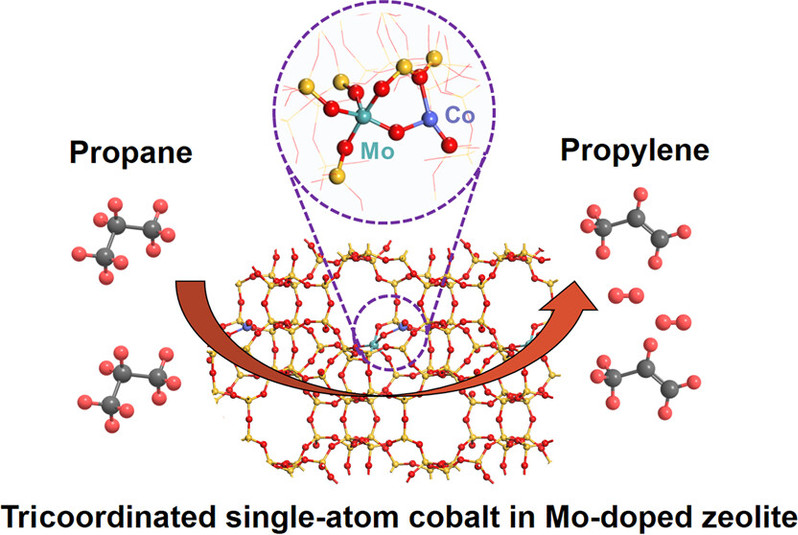Tricoordinated Single-Atom Cobalt in Zeolite Boosting Propane Dehydrogenation
Ziqiang Qu1, Guangyuan He2,3, Tianjun Zhang4, Yaqi Fan5,6, Yanxia Guo7, Min Hu8, Jun Xu8, Yanhang Ma5,6, Jichao Zhang9, Weibin Fan7, Qiming Sun1*(孙启明), Donghai Mei2,3*(梅东海), and Jihong Yu10*(于吉红)
1Innovation Center for Chemical Science, College of Chemistry, Chemical Engineering and Materials Science, Jiangsu Key Laboratory of Advanced Negative Carbon Technologies, Soochow University, Suzhou 215123,P. R.China
2School of Environmental Science and Engineering,Tiangong University,Tianjin 300387, P. R. China
3School of Materials Science and Engineering, State Key Laboratory of Separation Membranes and Membrane Processes, Tiangong University,Tianjin 300387, P. R. China
4State Key Laboratory of New Pharmaceutical Preparations and Excipients, College of Chemistry and Materials Science, Hebei University, Baoding 071002,P. R. China
5School of Physical Science and Technology, Shanghai Tech University, Shanghai 201210,P.R. China
6Shanghai Key Laboratory of High-resolution Electron Microscopy, Shanghai Tech University, Shanghai 201210,P.R. China
7State Key Laboratory of Coal Conversion, Institute of Coal Chemistry,Chinese Academy of Sciences, Taiyuan, Shanxi 030001,P. R. China
8National Centre for Magnetic Resonancein Wuhan, StateKey Laboratory of Magnetic Resonanceand Atomic and Molecular Physics, Innovation Academy for Precision Measurement Science and Technology, Chinese Academy of Sciences,Wuhan 430071,P. R. China
9Shanghai Synchrotron Radiation Facility, Shanghai Advanced Research Institute, Chinese Academy of Sciences, Shanghai 201204, P. R. China
10State Key Laboratory of Coal Conversion, Institute of Coal Chemistry, Chinese Academy of Sciences,Taiyuan,Shanxi 030001,P. R. China
J. Am. Chem. Soc. 2024, 146, 13, 8939–8948
Abstract: Propane dehydrogenation (PDH) reaction has emerged as one of the most promising propylene production routes due to its high selectivity for propylene and good economic benefits. However, the commercial PDH processes usually rely on expensive platinum-based and poisonous chromium oxide based catalysts. The exploration of cost-effective and ecofriendly PDH catalysts with excellent catalytic activity, propylene selectivity, and stability is of great significance yet remains challenging. Here, we discovered a new active center, i.e., an unsaturated tricoordinated cobalt unit (≡Si–O)CoO(O–Mo) in a molybdenum-doped silicalite-1 zeolite, which afforded an unprecedentedly high propylene formation rate of 22.6 molC3H6 gCo–1 h–1 and apparent rate coefficient of 130 molC3H6 gCo–1 h–1 bar–1 with >99 % of propylene selectivity at 550 °C. Such activity is nearly one magnitude higher than that of previously reported Co-based catalysts in which cobalt atoms are commonly tetracoordinated, and even superior to that of most of Pt-based catalysts under similar operating conditions. Density functional theory calculations combined with the state-of-the-art characterizations unravel the role of the unsaturated tricoordinated Co unit in facilitating the C–H bond-breaking of propane and propylene desorption. The present work opens new opportunities for future large-scale industrial PDH production based on inexpensive non-noble metal catalysts.

链接://pubs.acs.org/doi/10.1021/jacs.3c12584